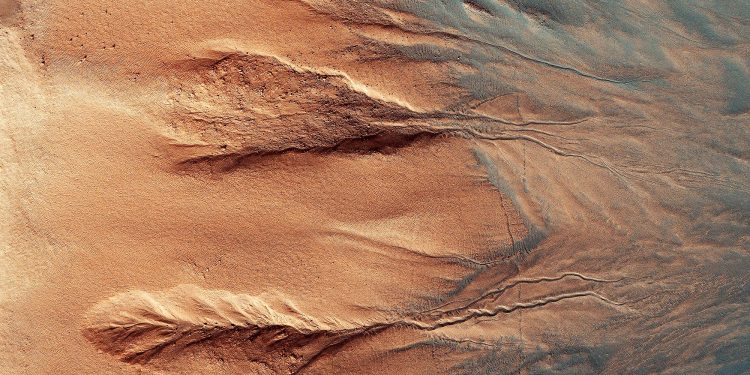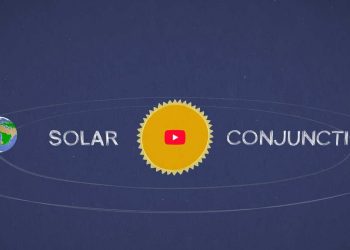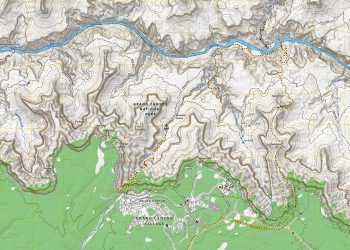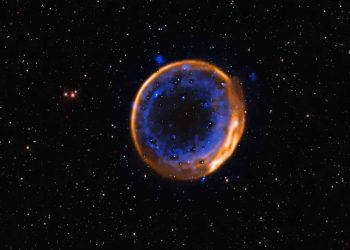When scientists first spotted long, narrow ravines cut into the sand dunes of Mars, some thought they might be signs of past life – or at least of flowing water.
That hope has dashed for the moment. But it turns out something else might be responsible for the formation of these alien features: exploding dry ice.
It’s true: Dry ice may be carving up the Martian landscape in ways we’ve never seen on Earth.
Lots of ravines on Mars
Mars has a reputation for being cold, dry and dusty. But it’s also surprising territory.
In some parts of the Red Planet, particularly in its southern hemisphere, the slopes of sandy dunes are carved with deep, winding ravines.
At first glance, these ravines on Mars appear to have been carved by flowing water, perhaps even melting snow or underground springs. But Mars is too cold and too dry for that, especially now.
In some places, temperatures can drop to minus 190°F (minus 123°C) during the winter. This excludes liquid water – at least most of the time.
Yet something had to dig into those long tracks.
When dry ice becomes a bulldozer
Scientists have long wondered whether dry ice (CO₂), also called dry ice, might be involved.
The thin Martian atmosphere is mainly composed of CO₂, and during the winter it freezes and covers the surface like frost. When spring comes, it warms up quickly.
When this CO₂ ice sits on warmer sand, it does not melt. It goes directly from solid to gas, a process called sublimation. This is where things get interesting.
In a recent laboratory experiment, researchers discovered that blocks of CO₂ ice – some up to 0.9 meters long – can actually embed themselves in sand and slide down on a layer of gas.
As the bottom of the block sublimates, the gas has nowhere to go. The pressure is mounting. SO . . . boom! The gas gushes out, throwing sand in all directions.
Dry ice and gullies of Mars
“In our simulation, I saw how this high gas pressure propelled the sand around the block in all directions,” said Earth scientist Dr Lonneke Roelofs of Utrecht University.
The escaping gas dug a pit around the block, pushing the sand to the sides and helping the block sink deeper into the slope.
But the process doesn’t stop there. As the block continues to turn into gas, it continues to push against the ground, slowly descending the slope and leaving behind a long, narrow ravine lined with sand ridges. This matches what scientists see on Mars.
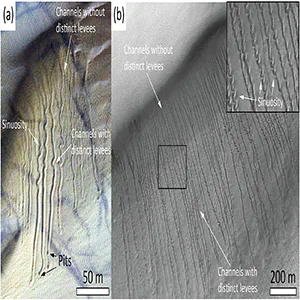
Looking for answers
To test this, Roelofs teamed up with master’s student Simone Visschers and traveled to Milton Keynes in England.
The Open University has a “Martian chamber” there, a sealed space where researchers can simulate Martian conditions such as temperature and atmospheric pressure.
They tried different slope angles and dropped blocks of CO₂ ice from the top. After a few attempts, things clicked.
“After finding the right slope, we finally saw results.2 a block of ice began to sink into the slope and move downhill, just like a burrowing mole or the sandworms of Dune. It looked very strange! » commented Visschers.
It was the first time anyone had observed dry ice behave this way – projecting through sand like a living creature. It’s a process that doesn’t happen naturally on Earth, because we don’t have the right conditions.
Where does dry ice come from?
CO₂ ice blocks form during the Martian winter, when a thick layer of dry ice – up to 70 centimeters (28 inches) – stretches across entire dune fields. As spring warms things up, most of the ice sublimates.
But the last remaining patches, often on the shaded sides of the dunes, can break away and collapse.
Once these blocks hit the slope, the warmer sand triggers more sublimation. The blocks descend, propelled by the escaping gas. Eventually, the CO₂ turns completely into a gas, leaving behind a gully in the sand.
Mars, Earth and the big questions
So what’s the point of studying all this?
“Mars is our closest neighbor. It is the only rocky planet close to the ‘green zone’ of our solar system. This zone is exactly far enough from the Sun to allow the presence of liquid water, a prerequisite for life,” explained Roelofs.
Thanks to this, it would be possible to study and answer questions about the origin of life, and possible extraterrestrial life, here on Mars.
“In addition, conducting research into the formation of landscape structures on other planets is a way to think outside of the frameworks used to think about Earth. It allows you to ask slightly different questions, which in turn can provide new insights into processes here on our planet.”
For now, Martian ravines don’t mean aliens or even past water. But they offer insight into a very different type of geology – a type of ice shaped by a type of ice we barely think about, acting in ways we’ve never seen before.
The full study was published in the journal Geophysical research letters.
Image credit: NASA/JPL-Caltech/MSSS
—–
Do you like what you read? Subscribe to our newsletter for engaging articles, exclusive content and the latest updates.
Check us out on EarthSnap, a free app brought to you by Eric Ralls and Earth.com.
—–


